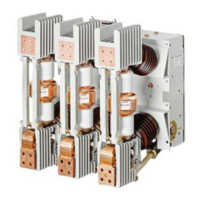26
Construction and mode of operation of
secondary shunt-release and
undervoltage release (refer to Figures 15,
16 and 17)
The release consists of a spring-power
stored-energy mechanism, a latching device
and an electromagnet.
These elements are accommodated side by
side in a housing (3.0), with a detachable
cover and three through-holes (5.0) for
fastening screws. The supply leads for the
trip coil are connected to a terminal block
(33.0).
The energy-storing mechanism consists of
the striker pin (23.0) and its operating
spring (31.0), which is mostly located inside
the striker pin (23.0). When the spring is
compressed, the striker pin is held by a latch
(25.0), whose sloping face is forced against
the appropriately shaped striker pin (23.0)
by spring (27.0). The other end of the latch
(25.0) is supported by a partly milled
locking pin (21.0), pivoted in the cover
sheets of the magnet armature (9.0). The
armature (9.0) is pivoted in front of the
poles of the U-shaped magnet core, (1.0)
and is pulled away from it by the tension
spring (11.0).
If the magnet coil (7.0) of the secondary
shunt release 3AX1101 is energized by a trip
signal, or if the tripping pin (15.0) is
mechanically actuated, magnet armature
(9.0) is swung against the pole faces. When
this happens, the latch (25.0) loses its
support and releases the striker pin (23.0)
that is forced out by the spring (31.0).
On the undervoltage release 3AX1103, the
latch (25.0) is held by the locking pin (21.0)
as long as the armature (9.0) is energized. If
the circuit of the magnet coil (7.0) is
interrupted, the armature (9.0) drops off,
thus causing the latch (25.0) to lose its
support and release the striker pin (23.0).
Following every tripping operation, the
striker pin (23.0) must be reset to its normal
position by loading the spring (31.0). This
takes place automatically via the operating
mechanism of the circuit breaker.
Figure 17: Undervoltage lock/operate selection
Figure 18: Capacitor-trip device
Position A: locked (disabled)
Position B: unlocked (enabled) (operating position)
Cancel the lock for the undervoltage release by shifting the locking screw (29.0)
from A (disable) to B (enable).
A
B
A
B
120 or 240 Vac
supply
01
T
24
23
52a
SD5
34
33
52a
A1
A2
52T
Capacitor trip
(+)
(-)
Rectifier
Resistor
(+)
(-)
1
2
Capacitor
Item Description
23.0 Striker pin
29.0
Undervoltage
enable/
disable
setting screw
23.0
29.0
29.0
23.0

